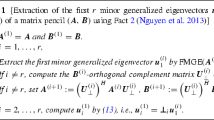Abstract
The contribution of this paper is three-fold: first, we propose a novel scheme for generalized minor subspace extraction by extending an idea of dimension reduction technique. The key of this scheme is the reduction of the problem for extracting the ith (i ≥ 2) minor generalized eigenvector of the original matrix pencil to that for extracting the first minor generalized eigenvector of a matrix pencil of lower dimensionality. The proposed scheme can employ any algorithm capable of estimating the first minor generalized eigenvector. Second, we propose a pair of such iterative algorithms and analyze their convergence properties in the general case where the generalized eigenvalues are not necessarily distinct. Third, by using these algorithms inductively, we present adaptive implementations of the proposed scheme for estimating an orthonormal basis of the generalized minor subspace. Numerical examples show that the proposed adaptive subspace extraction algorithms have better numerical stability than conventional algorithms.
Similar content being viewed by others
Explore related subjects
Discover the latest articles and news from researchers in related subjects, suggested using machine learning.References
Attallah S., Abed-Meraim K. (2008) A fast algorithm for the generalized symmetric eigenvalue problem. IEEE Signal Processing Letters 15: 797–800
Badeau, R., David, B., & Richard, G. (2005). Yet another subspace tracker. In Proceedings of the ICASSP (pp. 329–332).
Badeau, R., David, B., & Richard, G. (2006). YAST algorithm for minor subspace tracking. In Proceedings of the ICASSP (pp. 552–555).
Chang C., Ding Z., Yau S.F., Chan F.H.Y. (2000) A matrix pencil approach to blind separation of colored nonstationary signals. IEEE Transaction on Signal Processing 48(3): 900–907
Chatterjee C., Roychowdhury V. P., Ramos J., Zoltowski M. D. (1997) Self-organizing algorithms for generalized eigen-decomposition. IEEE Transaction on Neural Networks 8(6): 1518–1530
Choi S., Choi J., Im H.J., Choi B. (2002) A novel adaptive beamforming algorithm for antenna array CDMA systems with strong interferers. IEEE Transactions on Vehicular Technology 51(5): 808–816
Chen H., Sarkar T. K., Dianat S. A., Brule J. D. (1986) Adaptive spectral estimation by the conjugate gradient method. IEEE Transactions on Acoustics, Speech and Signal Processing ASSP-34(2): 272–284
Goldberg J. M., Fonollsa J. R. (1998) Downlink adaptive beamforming for spatially distributed sources in cellular mobile communications. Signal Processing 65: 181–197
Golub G. H., Loan C. F. V. (1996) Matrix computations, 3rd edn. The Johns Hopkins University Press, Baltimore
Hiraoka K., Hamahira M., Hidai K., Mizoguchi H., Mishima T., Yoshizawa S. (2001) Fast algorithm for online linear discriminant analysis. IEICE Transactions Fundamentals E48-A(6): 1431–1441
Levin M. J. (1964) Estimation of a system pulse transfer function in the presence of noise. IEEE Transactions on Automatic Control 9(3): 229–235
Mangasarian O. L., Wild E. W. (2006) Multisurface proximal support vector machine classification via generalized eigenvalues. IEEE Transactions on Pattern Analysis and Machine Intelligence 28(1): 69–74
Misono M., Yamada I. (2008) An efficient adaptive minor subspace extraction using exact nested orthogonal complement structure. IEICE Transation on Fundamentals E91-A(8): 1867–1874
Morgan D.R. (2003) Downlink adaptive array algorithms for cellular mobile communications. IEEE Transactions on Communications 51(3): 476–488
Parlet B. N. (1980) The symmetric eigenvalue problem. Prentice Hall, Englewood Cliffs
Peng D., Yi Z. (2007) A modified Oja-Xu MCA learning algorithm and its convergence analysis. IEEE Transaction on Circuits and Systems II 54(4): 348–352
Rao Y. N., Principe J. C., Wong T. F. (2004) Fast RLS-like algorithm for generalized eigendecomposition and its applications. Journal of VLSI Signal Processing 37: 333–344
Sadler B. M., Giannakis G. B., Shamsunder S. (1995) Noise subspace techniques in non-Gaussian noise using cumulants. IEEE Transactions on Aerospace and Electronic Systems 31(3): 1009–1018
Shahbazpanahi S., Gershman A. B., Luo Z. Q., Wong K. M. (2003) Robust adaptive beamforming for general-rank signal models. IEEE Transaction on Signal Processing 51(9): 2257–2269
Stone J. V. (2002) Blind deconvolution using temporal predictability. Neurocomputing 49: 79–86
Tanaka T. (2009) Fast generalized eigenvector tracking based on the power method. IEEE Signal Processing Letters 16(11): 969–972
Tanaka, T., & Tanouchi, H. (2010). Stable tracking of generalized eigenvectors with decaying window and projection approximation. Technical Report (in Japanese) (Vol. 110, no. 55, pp. 91–96) (SIP2010-16).
Wilkinson J. H. (1965) The algebraic eigenvalue problem. Clarendon Press, Oxford
Yang B. (1995) Projection approximation subspace tracking. IEEE Transaction on Signal Processing 43(1): 95–107
Yang J., Xi H., Yang F., Zhao Y. (2006) RLS-based adaptive algorithms for generalized eigen-decomposition. IEEE Transaction on Signal Processing 54(4): 1177–1188
Ye, M., Liu, Y., Wu, H., & Liu, Q. (2008). A few online algorithms for extracting minor generalized eigenvectors. In IJCNN 2008 (pp. 1714–1720).
Yosida K. (1980) Functional analysis, 6th edn. Springer, Berlin
Author information
Authors and Affiliations
Corresponding author
Rights and permissions
About this article
Cite this article
Nguyen, T.D., Takahashi, N. & Yamada, I. An adaptive extraction of generalized eigensubspace by using exact nested orthogonal complement structure. Multidim Syst Sign Process 24, 457–483 (2013). https://doi.org/10.1007/s11045-012-0172-9
Received:
Revised:
Accepted:
Published:
Issue Date:
DOI: https://doi.org/10.1007/s11045-012-0172-9



